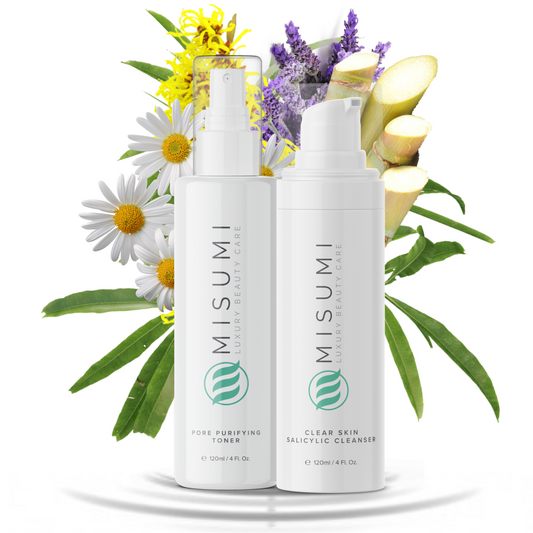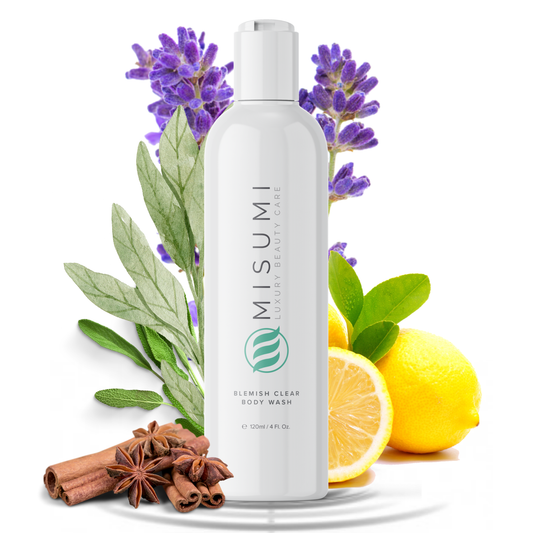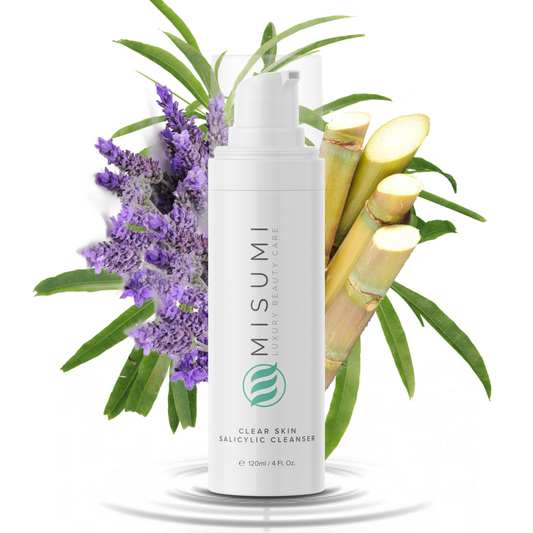Ever noticed how you don't really know anything about benzoyl peroxide, even though the name somehow pops up in every acne-treatment article? Let's be real; if you've ever looked for over-the-counter acne treatments, chances are you've heard or read about benzoyl peroxide.
And although there are other remedies, like Misumi's amazing Complete Clear 3-Step System and Clear Skin Duo Kit, let's find out what benzoyl peroxide can do for you.
Benzoyl Peroxide for Acne Scars
Benzoyl peroxide can help treat inflammatory acne lesions and related scarring. This is especially true for inflammatory acne. It should also help you shed dead skin cells, improve dark spots, and make the scarring less prominent.
Whether it's for mild acne or more severe lesions like acne scars, this organic peroxide is one of the first products you should get your hands on. Let's explain more about this amazing chemical.
It's had enduring popularity for many years now, which means it has a pretty strong reputation. It's also one of the most famous names associated with acne and acne scars treatments. Can we crown this chemical as a leader in its field? Well, let's not rush to any conclusions. We'll give you the information, and you can be the judge.
What is Benzoyl Peroxide?

Benzoyl Peroxide is an industrial chemical and medicine for acne and related scarring. It was first created in 1905. Once people started to recognize its powerful antibacterial and anti-inflammatory properties for the skin in the 1930s, they started using it in medicine. So, benzoyl peroxide has been helping people get rid of acne for over 80 years. How can we question a history like that?
What's more, the World Health Organisation has placed benzoyl peroxide on the list of essential medications. This means using benzoyl peroxide to treat and prevent acne is safe and effective. Synthesized in a lab, benzoyl peroxide has antiseptic, anti-inflammatory, and oxidizing properties, which help reduce the bacteria and yeast on the skin's surface.

Best of all, it accomplishes this without creating bacterial resistance - unlike other treatments. In fact, some sources claim it can even reduce bacterial resistance if it's caused by antibiotic therapy.
Benzoyl peroxide is an odorless white powder or granules with a chemical formula made to break down when in contact with the skin. When using it topically, benzoyl peroxide works by dissolving to release oxygen. This is lethal to the bacteria propionibacterium acnes - the most plausible culprit causing your acne.
You can use benzoyl peroxide as a cream, gel, or lotion or as a face wash at concentrations of 2.5 %, 5 %, and 10 %. Apart from acne treatment, benzoyl peroxide is used for many diverse purposes.
Benzoyl Peroxide Benefits and Uses

Being as popular as it is, benzoyl peroxide has made its way into a surprisingly large amount of practices. The most famous and typical uses of benzoyl peroxide are:
Acne Treatment
The strong antibacterial properties of benzoyl peroxide make this chemical one of the most popular over-the-counter treatments for treating acne and acne lesions.
Bleaching Hair

Just like other peroxides, benzoyl is a potent bleaching agent. If it gets into contact with fabrics or hair, it can cause permanent color change almost immediately. Even a towel that has been used to wash off benzoyl peroxide can cause bleaching effects.
Teeth Whitening Systems

The bleaching properties of benzoyl peroxide have earned it a place in many teeth-whitening products. Although not very common, this peroxide is sometimes used for whitening teeth.
Bleached Flour
Here's an interesting fact - freshly milled flour has a yellowish tint. The flour you see in the supermarkets is white because most brands use bleaching agents such as benzoyl peroxide, to make it white.
Removing Ink and Dye Stains on Vinyl Dolls and Other Toys

If you're someone who wants to DIY your own dolls, or restore the glow your toys once had, use benzoyl peroxide. It's really efficient in removing ink and other stains from toys.
Benzoyl Peroxide for Acne Treatment
Wondering about all those benzoyl peroxide benefits? As a chemical and medicine, benzoyl peroxide's primary use is to treat inflammatory acne lesions and inflammatory acne. It dissolves when it comes into contact with the skin, releasing oxygen that can be lethal to acne-causing bacteria - otherwise known as propionibacterium acnes.
This usually works like a charm since the bacteria can't live in an aerobic (oxygen-rich) environment. The oxygen released from benzoyl peroxide enters the pores, killing bacteria underneath. Reducing the bacteria population, in turn, reduces the number of breakouts.

According to the American Academy of Pediatrics (AAP), benzoyl peroxide is the most effective acne-fighting ingredient available without a prescription. If you have mild to moderate acne, or even severe cystic acne vulgaris, it should be able to help.
Another reason for benzoyl peroxide's popularity amongst cystic acne sufferers is because of its ability to help clear the follicle of excess dead skin cells. In this way, benzoyl peroxide helps prevent new acne outbreaks. Cleaning the pore of dead skin cells will reduce the chance of pore blockages or comedones.
Does Benzoyl Peroxide Help With Acne Scars?
Benzoyl peroxide can help with acne scars and even prevent an acne outbreak. It is most effective when used in combination with other treatments, such as topical retinoids.
Still not convinced? Well, benzoyl peroxide is completely safe to use on your skin in combination with other medicines. This includes other powerful anti-acne treatments like salicylic acid, sulfur, clindamycin (antibiotics), or adapalene (synthetic topical retinoids).
Studies have found that combination products, such as benzoyl peroxide and clindamycin, or benzoyl peroxide and salicylic acid, are slightly more effective than benzoyl peroxide alone for the treatment of more severe acne lesions and dark spots, as well as acne scars.
Benzoyl Peroxide Vs. Salicylic Acid

Another famous product against acne is salicylic acid. But what's the difference between these products, and which is the best treatment for acne?
Let us explain.
Salicylic acid is classified as a BHA or a beta hydroxy acid. It’s an anti-inflammatory ingredient that can help you treat acne. It works by removing dead skin cells from inside the pore and the skin's surface.
On the other hand, benzoyl peroxide is an antibacterial ingredient that gets inside the pore and kills the bacteria causing acne and inflammation. Both are wonderful ingredients with actual superpowers when it comes to skin problems. The main difference between them is that they attack different acne-causing sources.
Salicylic acid works on removing dead skin cells and excess oil from the affected area, while benzoyl peroxide kills the bacteria in clogged pores. If you want to which will be most effective for you, it's best to find out what's causing your acne breakouts in the first place.
Not sure which is the best treatment for you? You could also cover all your bases by using both ingredients together. We already mentioned that one big plus for benzoyl peroxide is its ability to work efficiently with other medications and anti-acne products.
So, why not try both?
Side-Effects of Benzoyl Peroxide

It would be great to get rid of acne without side effects, right? The truth is, treating acne is hard. Acne development is conditioned by a number of contributing factors, and no product, no matter how exceptional it is, can make everything go away. The stronger and more powerful the product, the bigger the side-effects list is.
Be aware that if you choose to use benzoyl peroxide, it has some downsides as well.
The most common side effects of benzoyl peroxide are dry skin, redness, peeling, skin burning, mild stinging, and skin irritation.
The good news is that, for most people, these side effects are dose-dependent and can be easily controlled. Still, if you have sensitive skin and experience these symptoms, avoid using benzoyl peroxide or at least consult with your dermatologist before continuing to apply.

In rare cases, some people may experience a more severe reaction, such as difficulty breathing or swelling. This might be due to an allergic reaction, and you should seek immediate medical attention.
Another side-effect of benzoyl peroxide happens because of its bleaching properties. It can bleach clothing and other fabrics on contact - so use it with caution. This's something to consider if you're applying it before bed. Don't make the pillowcases suffer!
It might take up to 10 weeks until you see skin improvement. This is not exclusive to benzoyl peroxide since all products need time to produce visible results, but it's something to bear in mind. Don't give up - instant solutions don't exist, and persistence is the key to winning the battle against cystic acne and acne scars.
To make sure you don't experience any side effects or an allergic reaction, read and follow the instructions on the product package or those given to you by your dermatologist.
Precautions

Make sure you're not allergic to benzoyl peroxide or some of the ingredients in the product before using it. If you're unsure, consult with your doctor or pharmacist before you apply benzoyl peroxide. Talk to your doctor about your medical history or any medication that you're currently taking - they may have to adjust your treatment plan.
Benzoyl peroxide is not proven to be safe to use during pregnancy and breastfeeding. Research on this is still lacking, so it's best if you avoid it while pregnant or breastfeeding.
Benzoyl peroxide can make your skin extra sensitive to the sun, so wear sunscreen! You might even need to limit your sun exposure for a while. Make sure you don't use it on broken skin.
How To Use

You can easily find a benzoyl peroxide gel or cream over the counter, but it's really important to consult with your doctor or pharmacist before using it to treat acne. The product usually comes with well-defined directions. Read the instructions carefully and ask your doctor if you have any questions.
If you're trying an anti-acne product for the first time, check for a negative reaction before applying it to the whole area. It's so easy to do a patch test. Apply a thin layer to one or two affected areas of the skin for 3 days. If no reaction occurs, apply the whole product.
Make sure you have clean skin before applying. Wash the affected area with nonmedicated soap and water, and then gently pat the skin dry with a towel. Then, apply the benzoyl peroxide to the skin - enough to cover the affected areas - and rub it in gently.
Dosage can be different for different people. Additionally, different products have different strengths. The standard dosage for acne and acne scar treatment is two or three times a day, but please, read the instructions on your product. Higher concentrations can cause skin irritation, redness, and burning - especially for those with a sensitive skin type.
You'll probably need to use the product long-term for the best results.
Final Verdict

What's the bottom line? You'll probably counter benzoyl peroxide many times in your search for acne-clear skin. Its long history and reputation speak in favor of this product.
Depending on the severity of your acne condition, you can try benzoyl peroxide as a stand-alone treatment or combine it with other potent products (such as other acne creams) to help you get rid of acne and more severe acne scars. Try benzoyl peroxide alongside Misumi's Complete Clear 3-Step System or Clear Skin Duo Kit to get the super soft, clear skin you've always craved.
Research has shown that combining a benzoyl peroxide gel with salicylic acid can boost the effectiveness of the products and increase your chances of getting rid of acne.
Beware of the potential side effects, and always follow the instructions. If you experience any side effects mentioned in the text above, please seek medical attention immediately.
It can take a while before you see improvement, which means that you need to be persistent and patient. But hey, the potential outcome is worth it, right? At the end of the day, benzoyl peroxide might put an end to your acne condition.









